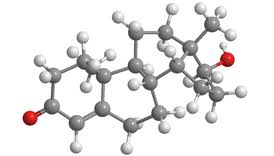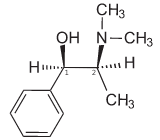
Methylephedrine
Methylphedrine is an ephedrine derivative used in some countries as a nasal anti-asthma and decongestant. For example, Asdrin in Japan contains methylphedrine. This substance has a structure similar to ephedrine and has similar properties and effects, it is also considered doping under current legislation if the concentration in urine exceeds 10 μg / ml.
Pseudoephedrine
Pseudofedrine is widely used over-the-counter as a nasal decongestant and cold remedy. This substance is a diastereoisomer of ephedrine (the same molecule, but with substituents in chiral centers in different positions) and can be reduced in methamphetamine by the body, therefore it is a sympathomimetic amine in all respects, however various studies show how to take this substance in dosages, even slightly exceeding therapeutic, does not affect the effectiveness and for this reason it was included in the number of substances to be monitored. Obviously, at higher dosages, it is a potent stimulant with the potential to improve athletic performance, as some studies show that 2.5 mg / kg of bodyweight taken 60 minutes before a competition is sufficient to increase endurance. To achieve an ergogenic effect, 180 mg is sufficient (about 3 times the dose used for refrigeration). This dosage has also been shown to improve performance in strength and anaerobic exercise (Gill).
It is currently considered doping if it exceeds 150 μg / ml in urine, but it is not clear whether the above dose (depending on 2.5 mg x kg) can lead to concentrations above the permissible limit, certainly a therapeutic dose remains well below it. The fact that this substance is usable, albeit to a limited extent, has prompted athletes to use it extensively in recent years, so much so that doping tests result in more cases of positivity than in the past.

Norefedrina
Noraphedrine (phenylpropanolamine) is an ephedrine derivative. This substance is found in several medicines: propalin is a veterinary drug for treating urinary incontinence that contains norephedrine; rinexine is a norephedrine-based nasal decongestant; it can also be found in combination with paracetamol and caffeine in analgesic products such as zerinol. It is currently used in some countries also in weight loss therapy at a dose of 75 mg per day (this dosage is much higher than in analgesics and decongestants) in combination with caffeine, in the United States marketing for this purpose has been suspended due to cases of hemorrhagic stroke, concomitant use of the drug for weight loss and possible ventricular hemorrhage. Norephedrine is a sympathomimetic believed to be less dangerous than amphetamines and has been shown to be more effective than ephedrine for weight loss in some studies. This substance is not prohibited, but it can falsely test for amphetamine, especially when used in non-therapeutic doses, as metabolic pathways lead to common metabolites.
Ethylephrine
Ethylphrine is a β1-adrenergic agonist that also acts on α- and β2-adrenergic receptors, marketed as ephfortil. it is used to treat hypotensive conditions due to its cardiac (positive inotropic) action and blood pressure, as a decongestant for the nose, it is also used to treat priapism (prolonged erection of the penis) such as phenylephrine, as they both cause indirect vasoconstriction α1.
There are no specific studies of the activity of ethylephrine in athletes, but it is expressly prohibited by anti-doping legislation, even if cases of positivity are decidedly rare. In fact, its cardiac stimulatory effects and β-adrenergic activity are ergogenic and should also reduce feelings of fatigue, even if no one has yet demonstrated it.

Famproprazone
Fampoprazone is an analgesic / antipyretic agent known as Gewodin but not marketed in Italy, listed as a stimulant, as it is metabolized to methamphetamine and can lead to false positives in tests.
Eptaminol
Eptaminol is a cardiac stimulant with a positive inotropic effect and a vasodilator. This active ingredient is used to treat cardiovascular disease, bronchospasm and orthostatic hypotension, alone or in combination with other cardiotonic substances. Heptaminol is contained in myotrophil and coreptile. Its actions are not yet fully understood, as it may promote the release of norepinephrine, but it also affects Ca2 + channels, increasing intracellular calcium and cardiac muscle activity.
An increase in cardiac activity should help increase endurance, but there is no research to support this, nor does it affect the central nervous system, in no way improve fatigue resistance, so it seems like a drug of questionable effectiveness. however, in recent years, there have been several cases of positive attitudes towards heptaminol in various sports, from swimming to cycling; in high doses it also produces false positive amphetamines.

Isometepten
Isometeptene is a sympathomimetic vasoconstrictor used in the treatment of migraines. It is found in combination with paracetamol and dichlorpenazone in headache products such as midrin and amidrin, in other products it is associated with caffeine as an analgesic, it is also used as an antispasmodic. Isomeptene is a direct and indirect stimulant of adrenergic receptors. There are no specific studies that can demonstrate the true ergogenic properties of this substance, however, it appears to be a mild stimulant compared to molecules such as amphetamine, and a secondary metabolite of this substance appears to be converted to heptaminol during an anti-doping test, resulting in false triggering.
Isometeptene is a substance that often leads to an involuntary violation of the anti-doping code, as it is present in over-the-counter pharmaceuticals, and also many ignore its presence on the prohibited substances list.
